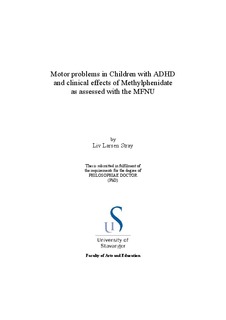Motor problems in children with ADHD and clinical effects of Methylphenidate as assessed with the MFNU
Doctoral thesis
Permanent lenke
http://hdl.handle.net/11250/185947Utgivelsesdato
2009Metadata
Vis full innførselSamlinger
- PhD theses (HF-LS) [21]
Originalversjon
Motor problems in children with ADHD and clinical effects of Methylphenidate as assessed with the MFNU by Liv Larsen Stray, Stavanger : University of Stavanger, 2009 (PhD thesis UiS, no. 84)Sammendrag
The Motor Function Neurological Assessment (MFNU) has been developed over a 25 year period based on clinical observations and
assessments of children referred for evaluation of possible Attention Deficit Hyperactivity Disorder (ADHD)/Hyperkinetic disorder (HKD).
The sub-tests of the MFNU were constructed to demonstrate these motor problems to parents and teachers of these children, and to make
changes in motor performance observable when the child was medicated with Methylphenidate (MPH, Ritalin©). The reliability and
usefulness of this instrument as a clinical assessment tool has been demonstrated through many years of clinical practice with hundreds of
children at the Birkelid Resource Centre prior to the start of the research. However, the MFNU was not originally constructed as a
research tool. Since the usefulness of the instrument in this respect is of
crucial importance to the validity of our research findings, much effort was put into development of a user manual and DVD with precise
instructions for test administration on each subtest, together with rules
of interpretation and scoring.
The aim of the research projects was to investigate possible relationships between ADHD symptoms and certain motor problems
observed in children with this diagnosis.
The first research question of our studies, using the MFNU as our research tool, was to establish to what extent the MFNU discriminates
between children with and without ADHD. In the first study 25 drugnaïve boys, aged 8-12 years and recently diagnosed as HKD F90.0, and
27 controls without ADHD participated. Highly significant differences
between the groups were found on all the MFNU sub-tests. A high
percentage of ‘severe problems’ was found in the ADHD group. The
control group typically presented few, if any severe problems. When
the ‘moderate problems’ and ‘severe’ scores were combined, the
ADHD group presented problems within a range of 80 to 96%.
The second research question was to investigate the effect of MPH on
motor problems in children with ADHD. Twenty-five drug-naïve boys,
aged 8-12 years and recently diagnosed as HKD F90.0 participated. A
double-blind, placebo controlled, cross-over design was applied, using
MPH or placebo capsules. The children were assessed individually with
the MFNU twice a day on two different days, with at least one day
Summary
- 12 -
interval. The first trial each day was baseline and the second was the
experimental condition. Significant improvements were found on all
sub-tests when comparing Baseline to the MPH trial. A Cohen’s d of
1.27 was found, applying ‘Total score’ from the MPH and the Baseline
trials. The most pronounced improvements with MPH compared to
Baseline were observed on sub-tests assessing high muscular tone.
The third research question was to investigate to what extent motor
problems are present in positive responders to MPH on their core
behavioural problems of ADHD, compared to non-responders. The
study group consisted of 73 children. They were retrospectively divided
into two sub-groups based on their response to MPH on their core
ADHD problems: ‘Medicine responders’ and ‘Non medicine
responders’. Highly significant differences were found between the
groups on MFNU sub-tests and the ‘Total Score’. The responder group
obtained a significantly higher median score than the nonresponder
group on all sub-tests. No significant gender or age differences were
found in the responder group, nor in the nonresponder group, on any of
the MFNU sub-tests.
A case study describes changes in motor function on MPH medication
in children who did not fully satisfy the ADHD criteria, but were
positive medicine responders. The two children were diagnosed with
47, XYY syndrome. The MFNU served as an important supplement in
the evaluation of MPH treatment in these children. This shows that the
MFNU is valuable in assessment of other syndromes than ADHD.
We have shown that the MFNU is a sensitive instrument in the
assessment of motor inhibition and high muscle tone in trunk,
shoulders, hips and legs in boys with ADHD-C/HKD. The results from
the research presented in this thesis support our clinical observations
regarding specific motor problems in children with ADHD. We found
such problems both in the diagnostic group in general and in children
with ADHD, who respond positively to central stimulant medicine, in
particular. A single dose of MPH in boys diagnosed as ADHD-C
yielded a significant improvement of the motor problems. There was a
corresponding weaning effect after the metabolisation of the MPH
which is very similar to what is seen in the behavioural symptoms of
the syndrome. The results support our suggestion that there may be a
close relationship between the motor problems measured by the MFNU
and the neurofunctional causes of ADHD.
The MFNU is still in need of further validation research, particularly
regarding the use in diagnostic assessment.
Beskrivelse
PhD thesis in Reading research
Består av
Stray, L. L., Stray, T., Iversen, S., Ellertsen, B., Ruud, A., & Tønnessen, F. E. (2009). The Motor Function Neurological Assessment (MFNU) as an indicator of motor function problems in boys with ADHD. Behavioral and Brain Functions, 5(22). URL: http://www.behavioralandbrainfunctions.com/content/5/1/22Stray, L. L., Stray, T., Iversen, S., Ellertsen, B., & Ruud, A. (2009). Methylphenidate improves motor functions in children diagnosed with Hyperkinetic Disorder. Behavioral and Brain Functions, 5(21). URL: http://www.behavioralandbrainfunctions.com/content/5/1/21
Stray, L., Ellertsen, B., & Stray, T. (2010). Motor function and Methylphenidate effect in children with ADHD. Acta Paediatrica, 99(8), s. 1199-1204. URL: http://onlinelibrary.wiley.com/doi/10.1111/j.1651-2227.2010.01760.x/abstract
Ruud, A., Arnesen, P., Stray, L. L., Vildalen, S., & Vesterhus, P. (2005). Stimulant medication in 47,XYY syndrome. Developmental Medicine & Child Neurology, 47(8), s. 559-562. URL: http://onlinelibrary.wiley.com/doi/10.1111/j.1469-8749.2005.tb01192.x/abstract
